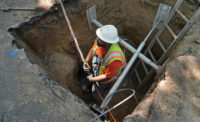Two separate assessments of the health of the Chesapeake Bay indicate that most jurisdictions within its watershed are not on track to meet target goals to cut nitrogen and phosphorus discharge levels by 2025. But new plans and programs put in place in 2022 could improve the restoration trajectory, according to the U.S. Environmental Protection Agency.
On Oct. 4, EPA released results of its evaluation of two-year environmental compliance milestones for bay jurisdictions that fall within its watershed: Maryland, Virginia, Pennsylvania, New York,Delaware, West Virginia and the District of Columbia. A day later, environmental advocacy group Chesapeake Bay Foundation released its annual State of the Blueprint report.
Both reviews were released a week before the bay’s executive council, made up of governors from those states, is to meet. The assessments concluded that though progress has been made over the past two years, most of the states' jurisdictions in the bay watershed will be unable to meet their pollution reduction targets by 2025, largely due to insufficient reductions from farms and increased urban runoff.
“Most of the partnership is not on track for 2025, but we are encouraged by significant recent progress made in the states,” Adam Ortiz, EPA's Mid-Atlantic regional administrator, said in a statement.
Nitrogen, phosphorus and sediment from farms, wastewater treatment plants and stormwater runoff degrade water quality in large bodies of water, such as the Chesapeake Bay, and often contribute to large algae blooms, which can be harmful to humans and can block sunlight needed to allow fish and other water-based organisms to survive.
Based on EPA’s review, Washington, D.C., and West Virginia are on track to meet their overall cleanup goals by 2025, but the other states are falling behind in their efforts.
The foundation's analysis noted that since the Chesapeake Bay Water Blueprint was established by state governors and EPA in 2010, states have put practices in place to reduce nitrogen by 42%, and phosphorus by 64%.
But that is not enough to protect the bay integrity and health, the group said. “The watershed cannot afford delay given the urgent challenges of climate change and growing populations. The states must demonstrate the leadership necessary to complete the job, and EPA must hold all accountable for any failures," said Hilary Harp Falk, the group's president.
WW Treatment Programs Lead Pollution Cuts
In most of the jurisdictions, upgrades to wastewater treatment plants have been the chief drivers of pollution reductions, the foundation said.
In Maryland, however, recent operational failures at two of the state’s largest facilities led to illegal discharges of pollutants into the Bay, according to a January lawsuit against Baltimore City filed by the Maryland's Dept. of Environmental Protection. The suit was dropped and a settlement reached in June when the Back River and Patapsco River wastewater treatment plants agreed to make repairs and implement operational improvements to prevent further discharges.
Additionally, runoff from developed land is a growing concern in Maryland, the foundation said. In August, the state Public Works board approved $65 million to fund projects to reduce flooding and stormwater runoff in Prince George’s County.
“This public-private partnership for green streets and other clean water projects in Prince George’s County will help us to meet our Chesapeake Bay goals while reducing flooding and growing our economy,” said Suzanne E. Dorsey, Maryland's environment deputy secretary, in a statement.
The foundation report highlighted some relatively new state programs in the watershed, such as the Stormwater Local Assistance Fund, which provides matching grants to municipalities in Virginia, and Pennsylvania’s $220-million Clean Streams fund.
The foundation noted that Virginia is behind in reissuing municipal separate storm sewer system permits. “The Commonwealth must reissue the remaining MS4 permits, continue investments in the Stormwater Local Assistance Fund to help municipalities reduce polluted runoff and strengthen regulations to accelerate pollution reductions,” the foundation said in its report.
Pennsylvania has consistently lagged behind other states, and twice has had to resubmit modified plans to EPA, most recently in August. The foundation said the state is not on track to meet pollution-reduction commitments and has not yet developed an "adequate plan that achieves those commitments."





Post a comment to this article
Report Abusive Comment